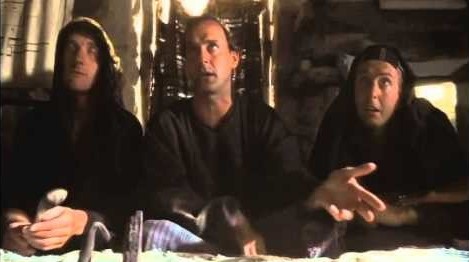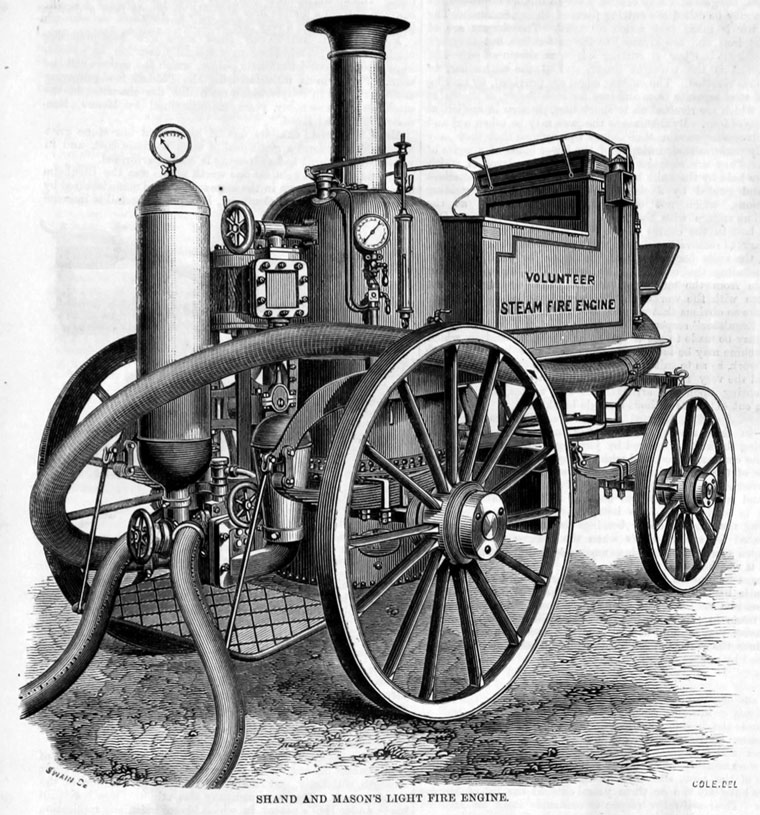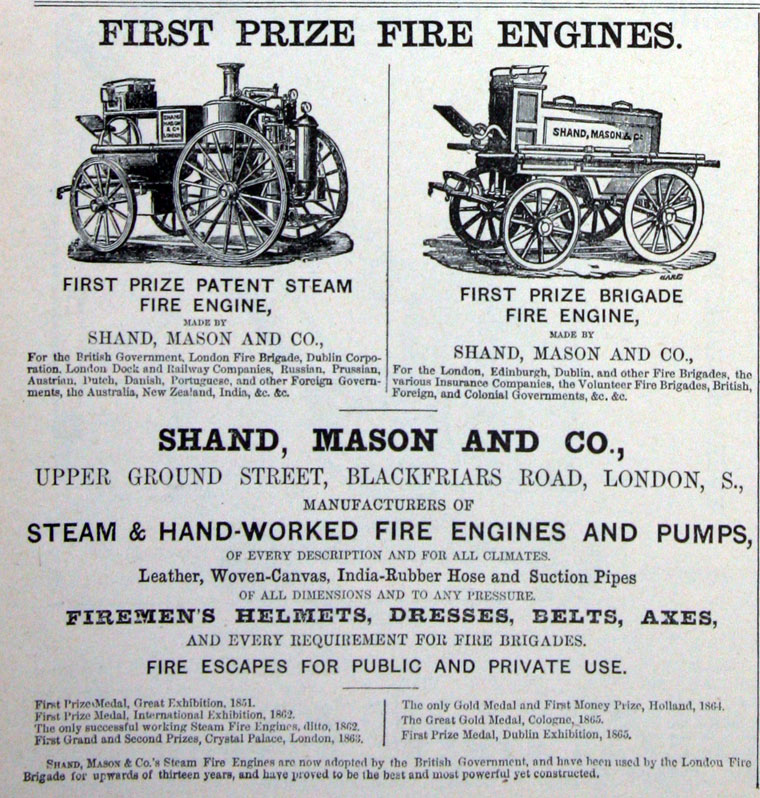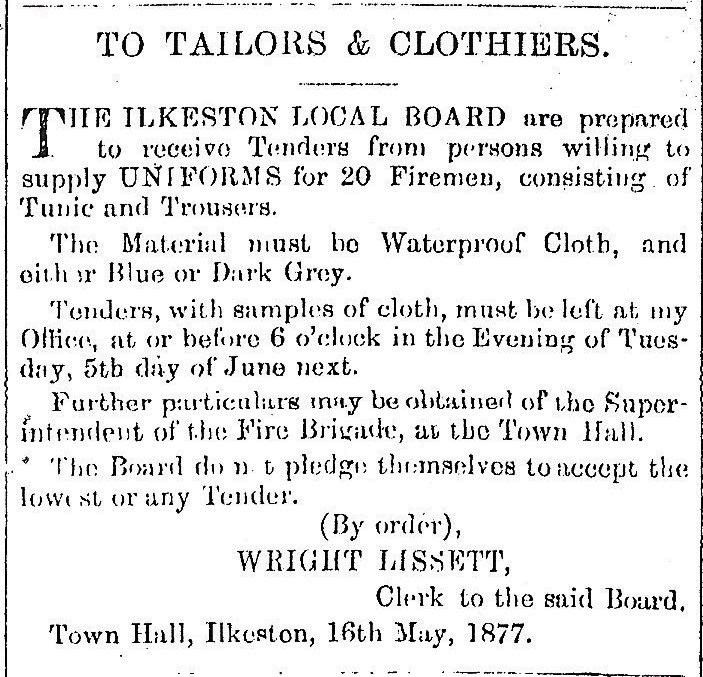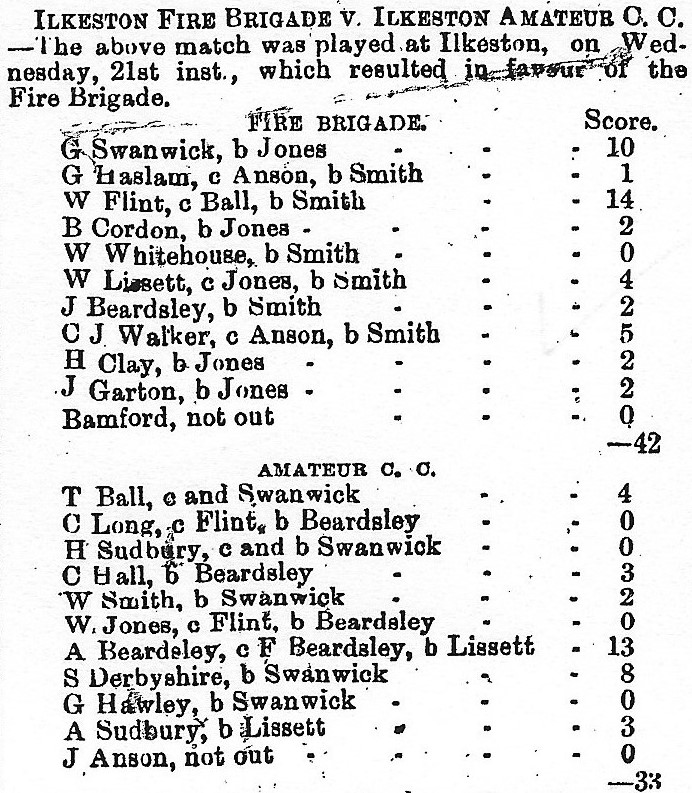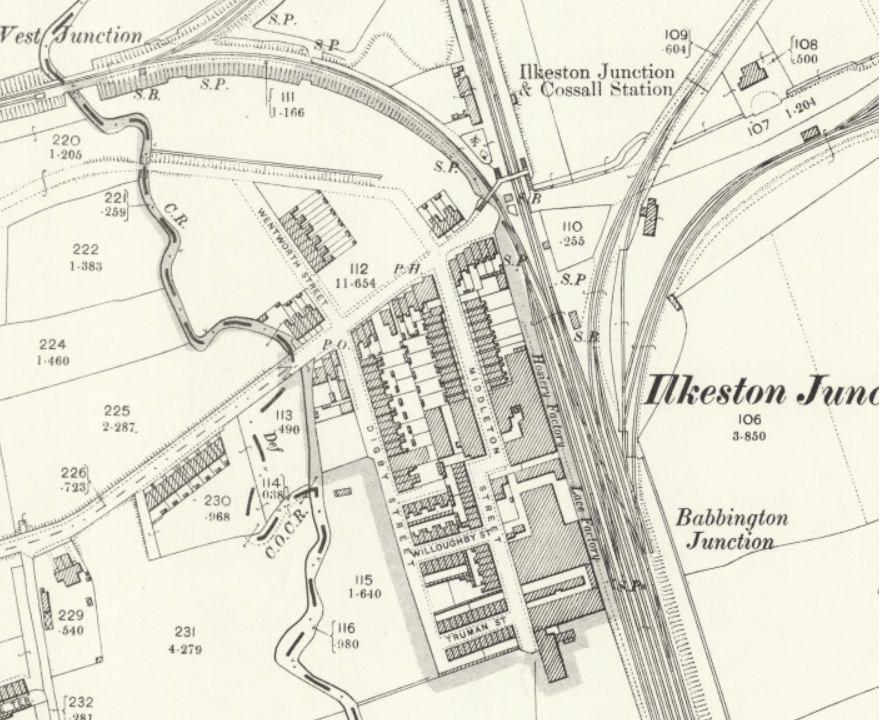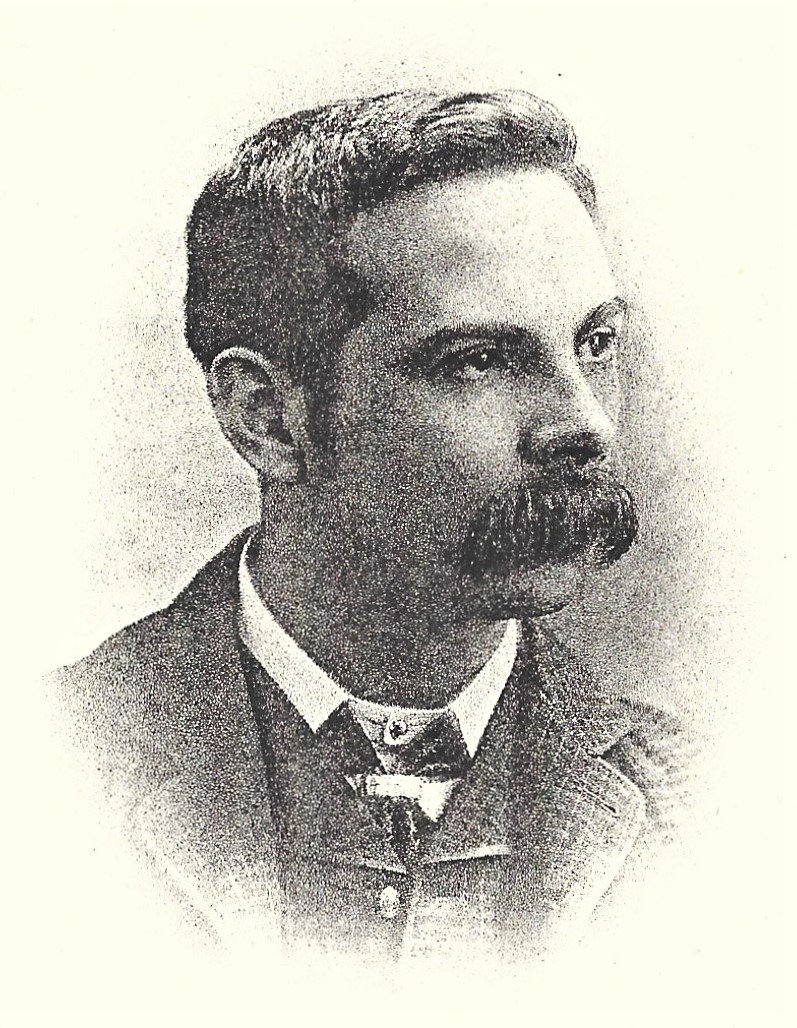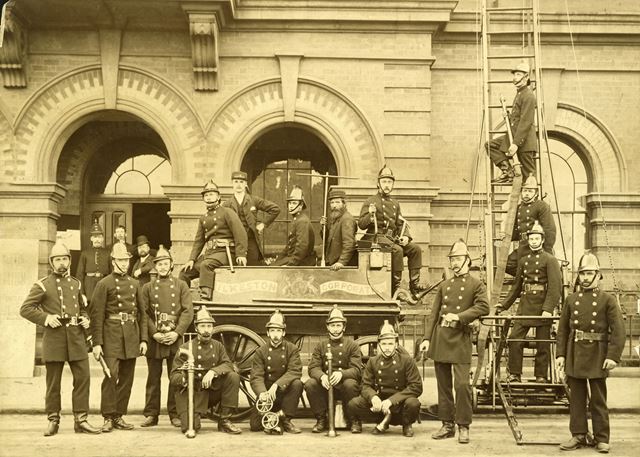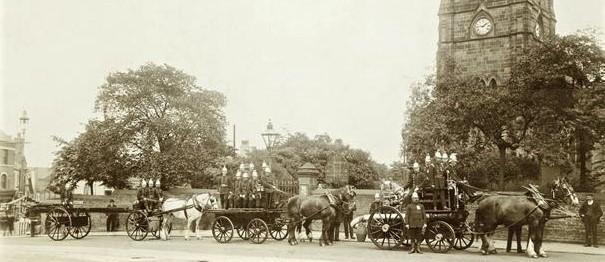Scene: Ilkeston illuminates and improves.
“apart from better sanitation and medicine and education and irrigation and public health and roads and a freshwater system and baths and public order …” (from ‘Monty Python’s Life of Brian’).
Under the aegis of the Local Board, Ilkeston was provided with a new Town Hall, a more effective sewage disposal system, improved gas and water supplies, ….
and a map !
———————————————————————————————————————————————————-
and a fire brigade !
In August 1867, after a fire virtually destroyed a haystack at Pewit belonging to Alexander Mellor Barker, — a fire only put out by the efforts of local helpers — the Pioneer posed a question;
“When will our Local Board and the Fire offices see after the purchase of a fire engine, and enlist the services of the volunteer brigade so handsomely offered a short time ago?
When a church, chapel, factory, or a row of shops have fallen by fire, we may perhaps expect to see some movement by our authorities for the safety of property in the town. Why not act at once, be ready for such emergencies?”
Don’t hold your breath ! The Pioneer – and the rest of Ilkeston – had to wait almost a decade before its wish was fulfilled.
In August 1873 a fire at the stackyard of the Rutland Colliery Company, just past the Poplar Inn, was almost the catalyst for the formation of a fire brigade. Dramatically the Pioneer reported that “the fire lit up the whole town, and caused great excitement. At one time fears were entertained that the flames would reach a thatched house adjoining the stackyard, and the goods were hastily removed”. Once more the Paper called for a Fire Brigade though it had no faith in the Local Board providing one ; “It seems that nothing less than the burning down of Ilkeston Town Hall, or two or three chapels or factories will cause the Board even of thinking of purchasing a fire engine” … and finally “it is hoped that the fire … will arouse the Local Board to instant action” Action ? Yes, but not exactly ‘instant’.
In late 1876 the Board decided to provide the town with its own Fire Brigade, with an engine and appliances complete with “two lengths of suction pipe, one double connecting screw with stopcock, two goose necks and one portable canvas cistern”. The cost of the engine, made by Messrs. Shand, Mason, and Co. of London, with all the necessary appliances was £329 and it was bought and delivered in May 1877.
Splendidly drilled by Superintendent Knight of the Nottingham Fire Brigade, members of the Ilkeston brigade were initially kitted out with tunic, trousers, helmet, belt and axe.
Mr. G. Proctor of Ilkeston was chosen to make the tunics and trousers – at 44s 6d per pair.
There were helmets and hatchets for a dozen firemen and it was intended that the brigade crew should number 15.
A stable at the rear of the Town Hall was converted into a fire engine house with sheds, housing and new stables built on Local Board land in Pimlico, by William Warner 1877-1878.
The cart sheds in Pimlico were built by bricklayer/builder Henry Walter Flint of Bath Street.
Two cottages with a boundary wall were to be built in Pimlico for the horse keepers.
The Board felt that it would be unfair to call upon ratepayers to pay for part of this expenditure so it tried to raise the finance for the fire engine and its buildings through public subscription. A great number of requests were sent to employers, landowners, insurance societies and tradesmen throughout the area but only two replies were received. Consequently a loan of nearly £1200 was secured, though not after a public inquirey was held in Sepetember of 1877, after which the loan (with conditions) was signed off by the Local Government Board. It turned out that not all of it was needed.
A correspondent to the Nottinghamshire Guardian noted that a significant difficulty might now arise, viz… Ilkeston’s great scarcity of water. The Local Board had been long negotiating to buy the Waterworks from its shareholders with a view to extending the provision of water in the town but so far the owners had not been satisfied by the Board’s offer.
“It remains to be seen whether the Board will increase their offer or purchase a fire-engine to extinguish fires without water”.
Members of the first Volunteer Fire Brigade of Ilkeston (August 1877).
Superintendent; George Haslam, surveyor and architect of 5 East Street.
Foreman; Benjamin Cordon, plumber and glazier of 87 Nottingham Road.
Engineer; William Gregory, butcher of 13 Burr Lane.
Sub-engineer; Gilbert Wilkinson, pork butcher of 26 Granby Street.
Crew; George Andrew, E(dward?) Attenborough, , J. Beardsley, Henry Clay (junior?), William Flint, Robert Fretwell, Henry Higgitt, Frederick Shaw, H. Smith, A. Sudbury, , Charles J. Walker, George Whitehouse, J. Wilkinson, W. Wilkinson, G.H. Wright.
Secretary; George Swanwick.
Surgeon; Henry George Brigham esq..
Person to be warned in case of a fire; Inspector Cowley at the Police Station.
(Notice that the number in the force had swollen from the original quoted).
In late 1878 the brigade attended a night fire and had difficulty in operating in the dark.
The same fire was also attended by the Derby Brigade and the Ilkeston lads noticed a significant difference between the two forces – all the members of the Derby Brigade had Bull’s Eye lamps!! Consequently in November 1878 the equipment of the Ilkeston Fire Brigade was upgraded.
The new fire engine was first ‘used in anger’ in October 1877.
At about midnight farmer William Hollingworth of the Grove Farm in Stanton by Dale smelled burning and, gazing out of his window, saw a large haystack — about 40 tons of hay — burning brightly and lighting up the whole neighbourhood. While locals did what they could to help put out the fire, messengers on horseback were dispatched to both Derby and Ilkeston to raise the alarm and call on the fire brigades there. Naturally the Ilkeston brigade arrived first and had the fire under control before the Derby engine reached the scene. The local brigade “conducted itself in a manner exceeding the most sanguine expectations”.
Perhaps the Brigade’s expectations were sanguine when they formed a Cricket team to play the Ilkeston Amateur C.C. in May 1879. Whatever their hopes, they did pull off a win though only two of the team – George Swanwick and William Flint — scored double figures.
And here (right) is a full card for those interested …
I am unsure how often the team played after this, though there was at least one match, in August 1887, at Long Eaton Recreation Ground against the fire brigade team of that town. By then the Ilkeston team had had a complete ‘revamp’, some of the new eleven being “well-known in the cricket field” — they thumped their opponents by over 100 runs !!
The fire brigade at work
In October 1880 the Pioneer reported that “owing to some dissatisfaction a great many members of this newly-formed brigade have sent in their resignations so that at present it is far below its usual strength”.
August 27th 1885 … and here’s an irony !!!
The fire brigade was called out to Hallam Field sewage farm, to put out a fire in a stack of hay belonging to — you guessed it ! — the Local Board. And when the brigade arrived it was not needed. The locals had done the job already !!
January 13th 1893 (4.15am) …. a fire at Stanton Ironworks.
This began in the south corner of the fitting shop. The alarm was given quickly and after 30 minutes the brigade had been fully assembled; by 6.30am the fire was under control thanks to the brigade and a plentiful supply of water from the nearby Erewash Canal. At that point the Nottingham Fire Brigade arrived but, seeing itself surplus to requirements, had no need to untackle.
Damage was estimated at £600-£700.
A word of praise is due to the energetic way in which the local brigade performed their duties. It was altogether due to them that the fire did not catch the pattern shop; if it had done so the damage would have been much greater.
January 19th 1893. Disaster at Middleton Street
Considering the fire-fighting equipment and resources being used at this time, and the fact that no-one had to volunteer to enlist in the fire brigade, perhaps we should reflect upon the sense of civic responsibility, the bravery and dedication to duty displayed by its members — responsibility, bravery and dedication which were tested again, on January 19th, less than a week after the Ironworks fire, when Ilkeston’s district experienced the most calamitous factory fire it had ever known.
Middleton Street lies in an area known as Ilkeston Junction, and as it is on the east side of the River Erewash (the border between Derbyshire and Nottinghamshire), the Junction is geographically not in the Borough of Ilkeston but in Nottinghamshire. You can see the river, meandering down the right hand side of the map below …
The Junction had been a barren area, prone to flooding, until, from the 1880s, buildings, including a tenement factory, began to be erected there. Initially these were used for engineering purposes but quickly proved to be unsuccessful. After a period of idleness, they were taken over in the mid 1880s and converted by Nottingham firms, into a lace factory. On the map, this older factory is seen as an inverted ‘T-shape’, while newer and larger factories were then added at each end of the old block, accompanied by a large number of houses for the factory hands.
About 150 feet long, the cross-piece of the ‘T-shape’ housed machinery belonging to the firm of lace curtain manufacturers, Messrs Pratt, Hurst, and Company. The rest of the building was occupied by three firms — Messrs Trueman and Gamble, Messrs Tattershall, Howard and Co. in the centre, and finally Mr. Trueman and Messrs Carrier (Henry and George) — all lace manufacturers. The whole building was known as Truman’s factory, two stories in height.
About 15 yards to the south, parallel to the cross-piece and connected to it by a covered passage about nine feet wide, was a four-storey factory — this was occupied by Messrs Pratt, Hurst and Company, by George Archer, by Thomas Birley, and by Joseph Truman of Carrington, Nottingham..
Between these two factories was the engine house and chimney.
To the north of these lace factories and a short distance away, was the large hosiery factory of James B. Lewis and Sons.
You might be able to locate all of these on the map ? — now try to locate the north-east corner of the cross-piece of Truman’s factory. It was there, on the lower room, that the fire of Thursday, January 19th, 1893 broke out.
Almost as soon as the morning shift arrived at 4 am, the fire had started — caused by a striking of a match to light the gas of the first lace machine ?? The flames rapidly spread to the seven other machines nearby and then a further two, at the far end of the room. Unable to quell the fire, the workmen were forced to hastily retreat; meanwhile the manager Thomas Marlow and Henry James Kilford, Captain of the Fire Brigade, had been called but they too were helpless. By 5 am the whole premises of Pratt, Hurst and Co. were ablaze.
Captain Kilford had summoned his men but as most of them were sound asleep when the fire broke out, it was half past five before the brigade had fully assembled in Middleton Street.
By that time the premises of Pratt, Hurst and Co. were beyond saving, while that of the neighbours in the same building were in serious danger. So too was the separate four-storey factory, such that it was considered opportune to isolate it by destroying the passageway connecting it to the inferno close by. This was quickly done and bags were hung at its doors, acting as a ‘fire blanket’, to prevent flames from getting into that building; thus the whole of that factory suffered no more than superficial damage.
Meanwhile there was serious danger to Tattershall and Howard’s place. Only separated from the seat of the fire by a brick wall and connected to it by wooden beams, urgent action was required. Nearby spouting was pierced at frequent intervals to allow water to run from the roof and down the walls, while the beams were chopped up and removed. These measures ensured that the manufacturing fabric of the Company was saved. Heavy losses however were incurred. There was much water damage to valuable and delicate machinery, and to expensive patterns … worst of all, the firm had allowed its insurance policy to lapse just a month ago !!
The scene …. “The sky was lurid with flame, and the whole district was lighted up as the roofs of the doomed factories fell into the roaring flames beneath. The people turned out en masse to witness the sight, and the police had great difficulty in keeping the crowd at a safe distance from the blazing ruins”.
The aftermath …. “Gaunt walls and tottering iron pillars point upwards, freed from the burden of floor and roof; on the ground level are huge masses of twisted machinery and shafting, heaps of burned-up patterns and valuable bundles of lace, and scrap iron and dust now represent what a few hours before was worth many thousands of pounds”.
And after the aftermath !!? …. don’t forget that this disaster took place inside the boundary of Nottinghamshire. Yet it was only after 10 o’clock that the Nottinghamshire police arrived on the scene. The Nottingham Fire Brigade had been telephoned for, but the exchange was unmanned and so the call didn’t get through !! A later telegraph message did the trick and the Brigade arrived, with very nice timing, just after 8 o’clock. By then the factories were gutted and the men of Ilkeston had the fire under complete control; the Nottinghamshire force thus returned home with clean hands and without a stain on their uniforms.
Half the block forming the ‘T-shape’ was saved though damage was estimated at £30,000 to £50,000. And as usual when calamity strikes, the workers at the factory were immediate sufferers, about 150 men and girls, … many of them were ‘workers’ no longer, though as it turned out. their ‘unemployment’ lasted only a few days.
The lessons to be learned ?? …. “a speedier system to call the men of the Fire Brigade together”; “more extinguishers inside each factory”; “One serious difficulty was the gas supply to the factories, the escaping gas blazing fiercely for hours and materially assisting the work of destruction”. No stop-tap could be found !! The gas men of Nottingham Corporation had to be called to dig into Middleton Street and cut off the supply … all under the tottering gable of Pratt, Hurst and Co.’s ruins.
Postscript ….
Captain Kilford’s report: “It was impossible to confine the flames to the place where they had broken out, because of the lack of assistance, and the connection of the roofs …. in Tattershall and Howard’s part of the factory the beams were lighted, but we kept the fire out by playing three jets on the roof, and having men inside with buckets. I thought it had gone two or three times … we left the scene at two o’clock in the afternoon”.
William Gamble’s remarks …. “Before the Brigade arrived a lot of workpeople and a bricklayer named Winfield worked hard to check the flames. The hose belonging one of the firms was got out and got to work, and buckets of water were poured on in great quantities. They turned the water onto the roof of Howard’s place, made holes in the gutter, and allowed the water to run down the hot walls. It was cruel to see the machiner drop into the lower storey”.
Thomas Marlow said …. “There were fire extinguishers in the factory, and the men used all they had got. If they had had enough of them I think they would have put the fire out”.
And a post postscript …. On February 10th a severe gale swept over Nottingham and into the Junction area where the precarious gable end of the factory of Messrs Pratt, Hurst and Co came under attack. Debris was blown onto the railway, telegraph wires were cut and the line was blocked for some time.
———————————————————————————————————————–
Cyril Hargreaves suggests that in the first years of the Borough Council, the only piece of apparatus available to the brigade “was a manually operated pump … about ten feet long, on four wheels … drawn either by a pair of horses or, more laboriously by the firemen themselves…. doubtless painted in the traditional red … bearing the Royal Arms and with the inscription ‘Ilkeston Corporation’ (added in 1887?)
The fire brigade on display outside the Town Hall, about 1900 (Seaman & Sons) … is that Captain Kilford on the left ?
And below, the same brigade in the Market Place about 1905, parading the new steam fire engine, purchased in 1902 (courtesy of Ilkeston Library)
I believe Captain Kilford has inserted himself again … this time standing beside the fire engine at the front of the parade.
———————————————————————————————————————————————————
and a petition !
In May 1879 the Local Board organised a petition, signed by the ratepayers, exhorting the Duke of Rutland (who was owner of the Market Place) to alter the date of holding the annual statutes and pleasure fair from the last Thursday in October to the Tuesday in the Wakes week, which commenced the first Sunday after the 11th of October. The wakes and the statute fair frequently occurred in consecutive weeks and the Board considered this to be disruptive to local trade and industries.
Some months previously the Duke had been asked to effect this change but declined to intervene unless it could be shown by petition that the inhabitants were in favour of it.
————————————————————————————————————————————————–
and better street lighting !
At the end of 1865 approval was granted to erect 40 additional lamps in the town, mainly placed at Kensington and Cotmanhay. To finance this (and to pay for the production of a map of the parish), the Local Board borrowed a sum of £450 at 5%, repayable over 20 years. At the same time the existing 45 lamps were to be lit over the winter months.
But these new lamps were to bring new problems.
In 1867 Sarah Ann Meer, 11-year-old daughter of William and Mary (nee Harrison) of Park Road, was charged by the Board with damaging a lamp whilst using it for stone-throwing target practice. She faced a possible fine of two pounds or 14 days’ imprisonment but fortunately the case was settled out of court after a payment of six shillings. However as so many lamps had been attacked in this way, it appears that the Board was determined to seek the full penalty in any future case…so be warned! (Five years later Sarah Ann’s father and his mate, Thomas Smith, were in trouble with the same Board for causing an obstruction on the footpath in Market Place but escaped with a reprimand after apologising to the Board.)
In 1871 Arthur Davis, eight-year-old son of Isaac and Sarah (nee Trueman) of Cotmanhay Road appeared before the members of the Local Board and begged their pardon for climbing up a lamp-post and throwing stones at the Lamp-lighter. He promised to do so no more, was severely reprimanded by the Chairman of the Board, and forgiven.
STREET LIGHTING.
Sir, — About a fortnight ago the street lamps were cleaned and the gas lighted, which gave to the streets a cheerful appearance in the evenings. Dull and dark nights have followed, and the lamps and streets have been in darkness.
It is said that the Local Board, in their wisdom, decided that the lamps should not be lighted on the evening of the moon’s eclipse*, less the brilliancy of the gas should mar the effect of the eclipse: but why the lamps were not lighted on Saturday night – a busy market night, when the heavens were clouded in darkness, and the rain came in torrents – has not yet transpired. Perhaps it was to save the jackets of two lamplighters: the convenience and comfort of thousands of market people form no matter of consideration for the Board.
So commonly have the lamps been lighted during moonlight, and non-lighted in the darkest of nights, it would seem agreeably startling now if any one of the well-paid servants of the Board had authority to and would light during exceptionally dark nights (when the moon refuses to shine, and could be made responsible for non-lighting, and the properly cleaning of lamps.
The present management of the lighting business augers badly for the Board undertaking the management of the Gas works altogether.
Yours respectfully, WATCHMAN. (August 30th 1877)
*There was a lunar eclipse on August 23rd 1877.
The Lamplighters continued to feel the full force of the Pioneer’s sarcastic wit !!
DUTIES OF LAMPLIGHTERS.
In the winter season, when nights are dark, do not light the lamps – certainly not until the moon has risen to light the path of the lighter.
In the summer season, especially at times when the moon shines full and clear, do not fail to light every lamp an hour or two before sunset.
These rules having been so implicitly observed during this year, the Board will probably consider the lighters, or those who have instructed them, entitled to a further advance of salary. (IP November 1880)
By July 1881 the town had 134 street lamps estimated to be worth £201.
—————————————————————————————————————————————————————–
and road building and improvement !
In 1866 the Local Board agreed to take all the tar made by the Gas Company, paying 1d per gallon, in order to mix it with cinders and gravel, to improve the road surfaces; previously only cinders and gravel were used.
As usual the Pioneer was the Board’s loudest critic.
This section began with that newspaper pouring scorn on the road-building skills of the Highway Board of the 1850’s.
An here is Tatler in the same newspaper, over 25 years later, writing about the Local Board.
“ … can anyone who is acquainted with the wretched condition of our streets and roads honestly aver that they are or have been as well attended as they ought? They are simply disgraceful, and are considerably more dangerous from the slovenly manner in which they have been mended (?) than if they had been let alone.
“I have before pointed out the folly of using furnace slag for repairing roads whereon there is heavy traffic, and the present condition of our thoroughfares fully confirms my views…. There is no toughness – no wear in it. But when it is thrown down anyhow, after the manner to be seen in our midst, and is composed chiefly of boulders and dust, no wonder that horses and pedestrians stumble over it, or have to wade ankle deep through troughs of mud…..
“Let (the Local Board) or their surveyor go and inspect some of the old coach roads that yet exist; or let them try, say fifty yards of Bath-street, with a twelve-inch layer of similar stone to what Macadam used, and they will never use furnace slag again.
“In the meantime, cannot they avail themselves of some of the superfluous labor that is standing idly at our street corners just to clear off the sludge which is lying about, and to smash up the dangerous lumps that refuse to be kicked to piece? Verb. sap. (A word to the wise is sufficient)”. (IP February 1879)
————————————————————————————————————————————————————-
and a new sewage system
The Blaxall Report of 1881 identified many weaknesses in the sanitary conditions and health environment of Ilkeston, but it did note that improvements had or were being made. And one of them was the development of a new sewerage system. So, at the end of November 1882 the Local Board appointed Benjamin Shaw Brundell of Doncaster as the engineer to carry out its sewerage scheme.
On April 10th 1884 the members of the Local Board made an official inspection of the newly completed ‘sewage works’ for the town — engineered by Benjamin and built by William Cunliffe of Leigh at a total cost of over £10,000 … an inspection which started close to the Ebenezer Chapel in Awsworth Road. The guided tour did not, of course, include much of the town’s scenic beauty, though it culminated at the new sewage farm, extending over six acres with 30 filter beds.
Mr Brundell said that there were two sewers in that locality not yet connected with the scheme, as the surface water got into them, and it was desirable to keep all such water ot of the sewage. The large flushing tank on the east side of Ebenezer-street was then visited, and the party waited until the large syphon, which is placed in the collecting tank, operated. The tank is computed to hold 5000 gallons of sewage and receives all the sewage from Cotmanhay. The sewage collects in the tank until it is full, when the syphon acts, and allows the sewage to rush off with considerable velocity in order to flush the sewers in the vicinity and keep them clear. (the sewage from the tank being forced in the direction of the sewage farm)
Mr. Brundell said that it would be a good plan for the Board to set on a man to count the number of times this tank discharged during the day. They would gain valuable information as to the amount of sewage they had to deal with from the Cotmanhay district.
The party then visited a ‘catch pit’ in Awsworth-road, at the bottom of which the sewage could be seen trickling along in a sluggish stream. The principle of these pits, for there are several in the scheme, is that the ordinary sewage passes through them into the main sewer; when, however, the volume of sewage is swollen by heavy rains, a floating weight connected with the door shuts off communication with the main sewer, and turns the stream water down another channel into the Erewash. Were it not for this arrangement the sewage farm would speedily be flooded out, and ruined.
Another of these ‘catch pits’ near the Midland Town Station was visited, after which the party drove to Hallam Fields to inspect the farm. Some distance from the farm proper is the ‘screen chamber’ through which the total volume of sewage can be directed on to any part of the farm, or into the Erewash, if necessary.
Close by is a ‘sludge pit’ intended to clear the tank of sludge. From here, up to the farm, trenches have been cut in the fields along which the sewage could flow, and Mr. Blundell said that the holder of this land could see that the sewage did not run on to any one spot for too great a length of time, or it would kill the vegetation. The sewage must be kept moving, or it would do more harm than good.
Prceeding to the farm proper the party were met by Mr. Crompton, J.P, and by Mr. Hopkin, representing the Stanton Iron works Co., the owners of most of the property in the locality, and who endeavoured some time ago, but in vain, to dissuade the Board from carrying out the scheme, on the ground that it would prove a nuisance to the locality. The various parts of the farm were now inspected, and the sewage was turned out on one of the prepared filtration beds for the first time by Mr. W. Wade. (Like breaking a bottle over the bow of a ship about to be launched ?)
The work is considered to have been carried out in a most satisfactory manner by Mr. Cunliffe, and it was hoped that the scheme would answer the expectations of the Board, and set at rest the long vexed question as to the disposal of the Ilkeston sewage. …. The total length of sewage from Botany Bay to the farm is between three and four miles. (Leigh Chronicle and Weekly District Advertiser Apr 25 1884)
We leave the ‘Sewage Issue’ there and will return in a decade’s time to see how, it is going.
—————————————————————————————————————————————————
The Local Board puts its foot down !
Wanton Mischief at Ilkeston. (September 1876)
Of late, and especially on Saturday nights, it has been the custom of certain individuals to amuse themselves by taking gates off their hinges and carrying them away, and other similar foolish practices. They have also smashed the locks off the gates of the Local Board’s nightsoil depots, and at length their freaks have become so intolerable that the Local Board have issued a reward for the conviction of the offenders which, it is hoped, will have the effect desired. (NG)
——————————————————————————————————————————————————
Following the Local Board Elections in April 1885 ….
Francis Sudbury was re-elected chairman…. the third time in succession. The Derbyshire Times and Chesterfield Herald felt that he must be a popular fellow and clearly doing something right.
On the Highway, Sanitary and Water Committee were George Haslam, Isaac Gregory, Walter Tatham, Edmund Tatham, Frederick Beardsley, Charles Mitchell, and William Sudbury, its chairman.
On the Finance Committee were William Fletcher, Alf Whitehead, Isaac Attenborough, Charles Maltby, Samuel Richards and its chairman William Tatham.
On the Gas Committee were George Haslam, Francis Sudbury, William Fletcher, William Sudbury, Peter Stanley, Isaac Gregory, and William Wade, its chairman.
On the Farm Committee were Isaac Attenborough, William Sudbury, Edmund Tatham, William Wade, William Fletcher, Isaac Gregory, and chairman Charles Mitchell.
————————————————————————————————————————————————–
And so … From Board to Borough.

